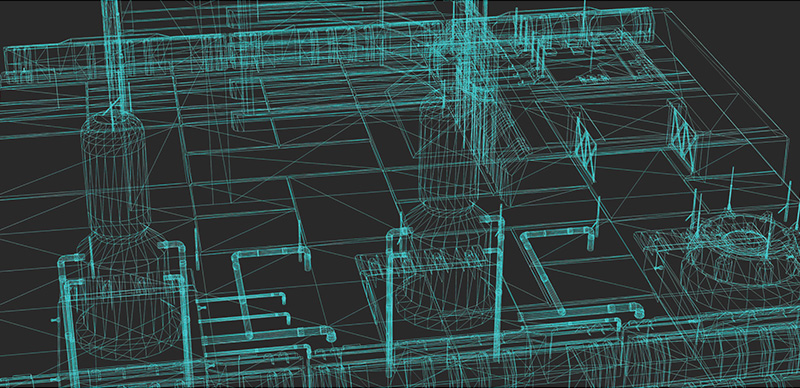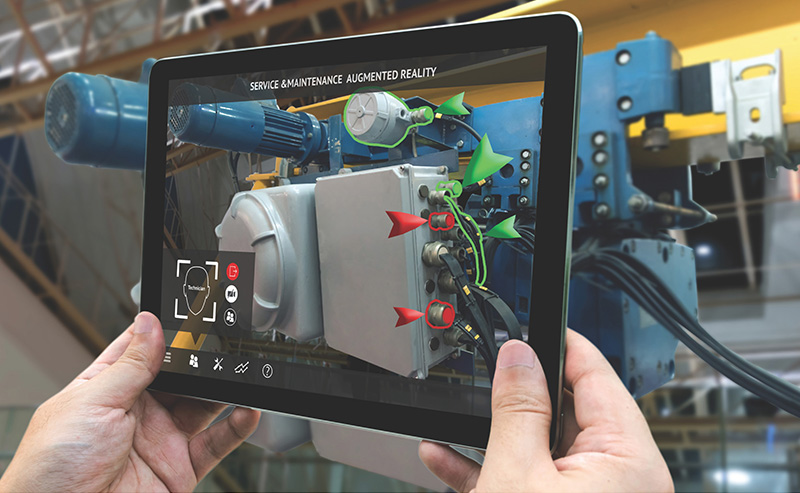• Back to Marketing Options Articles List •
Published September 2022
View as PDF:
Adding A New Dimension
The Next Generation of Collaborative Visualization Tools Have Arrived

Brian Judd, MEng
Design Engineer
Marketing Options, LLC
www.moptions.com
Article Takaways:
- 3D Visualization is a powerful tool for metal casting
- 3D Visualization improves effectiveness of communication, marketing, and training
3D VISUALIZATION:
WHAT AND WHY
3D visualization refers to a process where graphical content is created using 3D software. As a field, it encompasses a wide array of techniques for betterrepresenting designs and concepts. 3D Visualization extends to more immersive forms of presentation, as well as illuminating the smallest details in a design.
The overall process is simple, even when the details are complex. 3D Visualization starts with the creation of a digital model based on available reference material like CAD models, blueprints, photos, or measurements. This digital model can then be surrounded by virtual lights, placed in a virtual environment, and "painted" to look as realistic as desired. 3D Visualization presentations can take the form of digital still images, interactive images, videos, augmented reality depictions, or virtual reality simulations. In most cases, assets that were created for one type of visualization can be effectively used in multiple ways, such as creating an animated marketing video and then using the same 3D model in a VR training simulation.
There are as many approaches to visualization as there are concepts to present, but in all cases, the goal is to facilitate better communication. Improved communication leads to more effective collaboration, marketing, and training.
The metal casting industry is finding many applications for the technology from designing foundry floors, demonstrating equipment, simulating production processes, and for training when geography or physical restrictions are a factor.
3D VISUALIZATION APPLICATIONS
Until relatively recently, all the forms a 3D visualization might take were strictly passive. The viewer could only look at an image or watch an animated video. The addition of VR and AR technology was a huge leap that allowed users to interact with the 3D content, fully exploring it as desired. The global COVID-19 pandemic spurred further development of visualization tools to allow for the next step: real-time collaboration and design iteration. In the post-COVID world, just as online meetings have become ubiquitous, users can experience the same design visualization simultaneously and interact not only with the digital 3D content but also with each other.
Let's consider some different visualization types and how they can be deployed.
Digital Imagery
The 3D rendered still image is the most basic type of 3D Visualization, but a powerful marketing and training tool. The adage goes that "a picture is worth a thousand words", and science backs this concept. Studies indicate that the human brain processes visuals thousands of time times faster than text and that over 80% of the information that our brain processes is visual in nature. In several studies, when text-based instructions were accompanied by graphics, students’ test performance improved by almost 90%.
In any situation where it is either impossible or impractical to take photos, digital imagery can fulfill the need. Digital images can be created to illustrate flow through foundry processes, interior details of mold-filling, or how new equipment integrates with existing installations. Collaboration is possible in real-time with products that allow multiple users to add notations and markup over digital images during online meetings. Digital imagery can be used in print media, inserted into videos, as well as added to websites and social media.

Interactive Images
Online interactive images now allow users to view a 3D model interactively, from all angles. Users can zoom in to see minute details or zoom out to see large installations from normally-impossible vantage points. Users can explore freely, or be set to a guided mode that shows particular areas of interest. Interactive images can be used as an effective marketing tool that allows engineers to depict an entire facility layout as well as individual pieces of equipment. As a training tool, it enables learners to thoroughly familiarize themselves with equipment down to minute hidden details or to study facility configurations. Now this training can be done on-demand and at their own pace.
Much like digital still images, some tools allow multi-user collaboration with notations and markup added to interactive images online. Interactive imagery can be used on websites and social media, or at tradeshow booths.
Animated Videos
Videos are essentially a series of many still images strung together, sometimes with the addition of an audio track. But 3D rendered animated videos go much farther as a presentation tool; showing process flow, motion or change over time makes them invaluable for depicting industrial processes. With this tool, you can show molten metal solidifying from inside the mold, or illustrate all steps of the casting process throughout a foundry. Exploded views or cutaways can be created to clarify all aspects of a design or layout.
Technical or marketing videos can be used on websites, on social media, or shown at tradeshows.
Augmented Reality
Augmented Reality (AR) combines digital imagery or animation with a view of the real-world environment either with either a head-mounted display/goggles or using flatscreen devices with a camera. This allows for a straightforward depiction of additions or substitutions to the user’s environment, such as adding a large piece of equipment inside an existing industrial site. AR also allows users to view overlays in the real world, functioning as labels or highlights, that can act as guidance during training sessions or even during routine maintenance work.
Multiple users can gather in the same environment and be shown the same AR content, allowing for natural social interaction. With the right tools, those users can also make changes to the 3D model in real-time, or sculpt their own new additions to be added in a new design iteration. Multiple users can experience the same training session in AR, without scheduling conflicts and without interrupting production. AR experiences can be streamed online to remote users, set up in a dedicated space, or deployed in an exhibit booth.

Virtual Reality
Virtual Reality (VR) goes one step further than AR by placing the user in a fully synthetic environment that replaces their view of the real world. This means that users can view and interact with complete environments that are either inaccessible or haven't yet been built. Large pieces of equipment, such as melting furnaces, can be fully explored from the inside out for operator familiarization, and proposed facility layouts can be trialed before any commitment is made to actual construction.
As with AR, multiple VR users can be placed in the same virtual environment. However, in this case, they no longer have to be in the same physical environment, as all aspects of the digital content can be shared online. VR training, like AR, can be self-guided and on-demand and completed from any location. The same style of collaboration tools is available, allowing users to modify and add to the 3D models, add notations, and converse freely. VR simulations can be set up anywhere a small amount of floor space can be dedicated to it, including meeting rooms, offices, and tradeshow booths. VR modules can be added to a website for users to experience on their own from home or remote offices.
FITTING INTO YOUR WORKFLOW
Many products and visions can be created as a 3D visualization prior to execution, saving both time and costs for producers, manufacturers, and customers. 3D visualization provides the ability to show interior and exterior designs, layouts, lighting, texture, and even geography, before development. 3D visualization improves the manufacturing process by keeping up with design changes and evolving ideas. Engineers and production teams can work together to customize and realize concepts at any scale and iterate faster on designs while gathering feedback from clients.
